Avoid getting scammed by fake "Norton Subscription will renew today" emails
Phishing/ScamAlso Known As: Norton Subscription Will Renew Today spam
Get free scan and check if your device is infected.
Remove it nowTo use full-featured product, you have to purchase a license for Combo Cleaner. Seven days free trial available. Combo Cleaner is owned and operated by RCS LT, the parent company of PCRisk.com.
What is the "Norton Subscription will renew today" email?
"Norton Subscription will renew today" refers to an email spam campaign. These letters are disguised as subscription renewal notifications from NortonLifeLock. It must be emphasized that these emails are fake and none of their claims are true. They are also in no way associated with the Norton AntiVirus or NortonLifeLock.
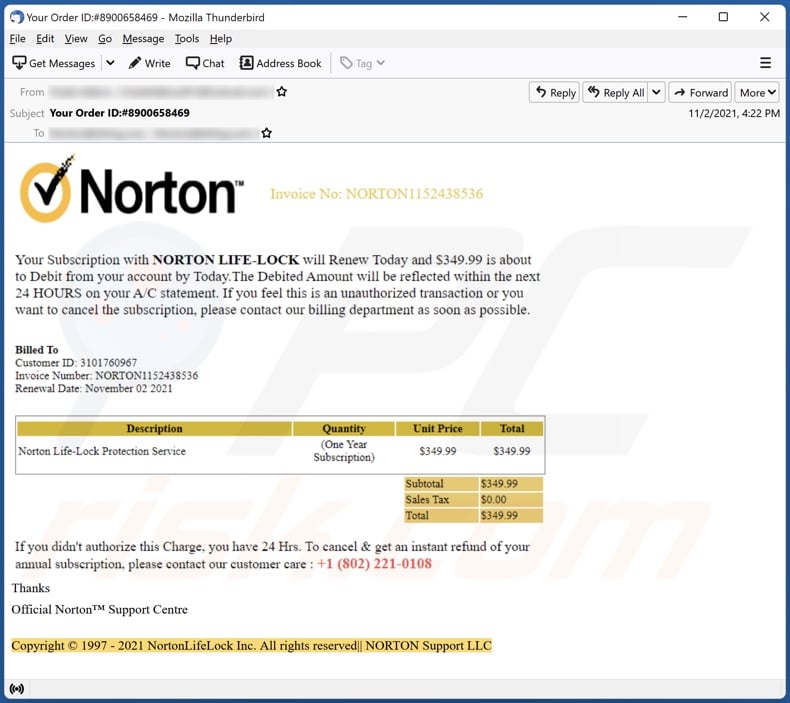
"Norton Subscription will renew today" email scam overview
The scam emails state that recipients will be billed 349.99 USD for the renewal of their Norton subscription. The amount will be deducted within 24 hours. Should users wish to cancel the subscription or think that this is an unauthorized transaction - they can contact the billing department and receive a refund.
It must be stressed that these emails are fake, and recipients will not be billed any amount. However, should the scam letters be trusted - that can result in a variety of serious issues.
Spam campaigns like "Norton Subscription will renew today" often operate as technical support and/or refund scams. The scheme begins when users are ticked into phoning fake support representatives/technicians. The cyber criminals then request victims to allow them remote access (via the use of legitimate software) to their devices. Once access is established, the scam model can vary.
Scammers can trick victims into disclosing private data (e.g., personally identifiable details, account usernames/passwords, credit card details, etc.) by simply asking for it, claiming that they cannot see it as it is being typed, through phishing websites, and so on.
Cyber criminals can also remove genuine protection software, install fraudulent purchasable programs (fake anti-viruses, etc.), or even infect the system with malware (e.g., trojans, ransomware, etc.). These actions can be performed under false claims of providing tech support like - uninstalling products, removing viruses, manually canceling subscriptions, etc.
Meanwhile, in refund scams - victims are asked to type the refund amount themselves while they cannot see the screen. By editing the HTML of victims' bank accounts - criminals create the impression that the refunded sum far exceeded the agreed-upon amount.
In fact, the funds present in the account remain unchanged, and it is only a ruse to force victims into transferring their own money to the scammers. Hence, when victims return what they believe to be the refund excess, they are, in fact - losing their own money.
Furthermore, cyber criminals typically demand the extra funds to be transferred in difficult/impossible to trace methods, thereby ensuring that victims would be unable to return their money and they could avoid persecution. Common tactics include requesting the amount to be paid in digital currencies (e.g., gift cards, pre-paid vouchers, cryptocurrencies, etc.) or in cash hidden within packages and shipped.
To summarize, trusting the "Norton Subscription will renew today" emails or similar scams - can result in system infections, serious privacy issues, financial losses, and even identity theft.
| Name | Norton Subscription will renew today Email Scam |
| Threat Type | Phishing, Scam, Social Engineering, Fraud |
| Fake Claim | Scam emails claim that recipients' Norton subscription will be automatically renewed within 24 hours. |
| Disguise | Scam emails are presented as notifications from Norton. |
| Scammer Phone Number | +1 (817)-776-5403, +1 (802) 221-0108, 877-395-5406, +1 (818)-(477)-(4341), 805 618 1078, (806) 884-4239, (866)-266-3467, +1 978 293 5500 |
| Symptoms | Unauthorized online purchases, changed online account passwords, identity theft, illegal access of the computer. |
| Distribution methods | Deceptive emails, rogue online pop-up ads, search engine poisoning techniques, misspelled domains. |
| Damage | Loss of sensitive private information, monetary loss, identity theft. |
| Malware Removal (Windows) |
To eliminate possible malware infections, scan your computer with legitimate antivirus software. Our security researchers recommend using Combo Cleaner. Download Combo CleanerTo use full-featured product, you have to purchase a license for Combo Cleaner. 7 days free trial available. Combo Cleaner is owned and operated by RCS LT, the parent company of PCRisk.com. |
Spam campaigns in general
"Norton cloud Subscription activated", "Download The Pending Mails Manually", "Sharpsmart Inc. Email Scam", "Your Outlook Account Was Logged In", and "WalletConnect Email Scam" are some examples of spam campaigns.
This mail can wear varied disguises and use different scam models. In addition to phishing and other scams, these emails are also used to proliferate malware. Due to how widespread spam mail is, it is strongly advised to exercise caution with incoming emails and messages.
How do spam campaigns infect computers?
Systems are infected via malicious files distributed as attachments or download links in spam emails. These files can be Microsoft Office and PDF documents, archives, executables, JavaScript, etc. When the files are opened - the infection chain is triggered.
For example, Microsoft Office documents cause infections by executing malicious macro commands. This process begins when a document is opened in pre-2010 Microsoft Office versions. Later versions have "Protected View" mode that prevents this automatic process; instead, users can manually enable macros (i.e., editing/content). It is noteworthy that virulent documents often contain messages designed to lure users into allowing macro commands.
How to avoid installation of malware?
Suspicious and irrelevant should not be opened. The attachments and links found in these emails - must not be opened, as they can cause system infections. It is recommended to use Microsoft Office versions released after 2010.
Aside from spam mail, malware is spread via dubious download channels (e.g., unofficial and freeware sites, Peer-to-Peer sharing networks, etc.), illegal activation ("cracking") tools, and fake updates. Therefore, it is important to always download from official/verified sources and activate/update programs with tools provided by legitimate developers.
It is crucial to have a reputable anti-virus installed and kept updated. This software has to be used to run regular system scans and to remove detected threats/issues. If you've already opened malicious attachments, we recommend running a scan with Combo Cleaner Antivirus for Windows to automatically eliminate infiltrated malware.
Text presented in the "Norton Subscription will renew today" scam email letter:
Subject: Your Order ID:#8900658469
Norton
Invoice No: NORTON1152438536
Your Subscription with NORTON LIFE-LOCK will Renew Today and $349.99 is about to Debit from your account by Today.The Debited Amount will be reflected within the next 24 HOURS on you A/C statement. If you feel this is an unauthorized transaction or you want to cancel the subscription, please contact out billing department as soon as possible.
Billed To
Customer ID: 3101760967
Invoice Number: NORTON1152438536
Renewal Date: November 02 2021
Description | Quantity | Unit Price | Total
Norton Life-Lock Protection Service | (One Year Subscription) | $349.99 | $349.99
Subtotal $349.99
Sales Tax $0.00
Total $349.99
If you didn't authorize this Charge, you have 24 Hrs. To cancel & get an instant refund of your annual subscription, please contact out customer care : +1 (802) 221-0108
Thanks
Official NortonTM Support Centre
Copyright © 1997 - 2021 NortonLifeLock Inc. All rights reserved NORTON Support LLC
Yet another example of Norton subscription renewal-themed scam email:
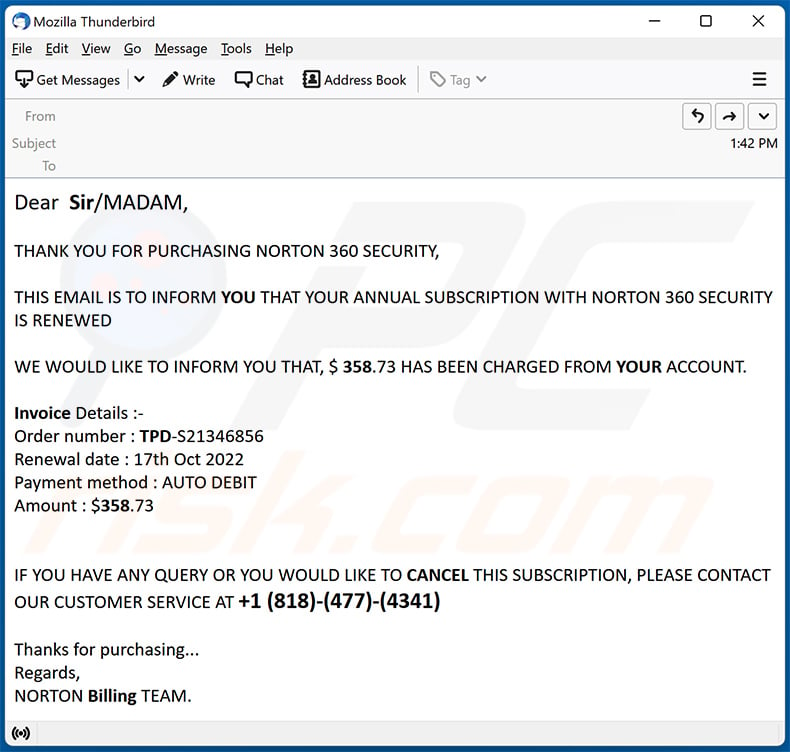
Text presented within:
Dear Sir/MADAM,
THANK YOU FOR PURCHASING NORTON 360 SECURITY,
THIS EMAIL IS TO INFORM YOU THAT YOUR ANNUAL SUBSCRIPTION WITH NORTON 360 SECURITY IS RENEWED
WE WOULD LIKE TO INFORM YOU THAT, $ 358.73 HAS BEEN CHARGED FROM YOUR ACCOUNT.
Invoice Details :-
Order number : TPD-S21346856
Renewal date : 17th Oct 2022
Payment method : AUTO DEBIT
Amount : $358.73
IF YOU HAVE ANY QUERY OR YOU WOULD LIKE TO CANCEL THIS SUBSCRIPTION, PLEASE CONTACT OUR CUSTOMER SERVICE AT +1 (818)-(477)-(4341)Thanks for purchasing...
Regards,
NORTON Billing TEAM.
Another example of Norton subscription renewal-themed spam email:
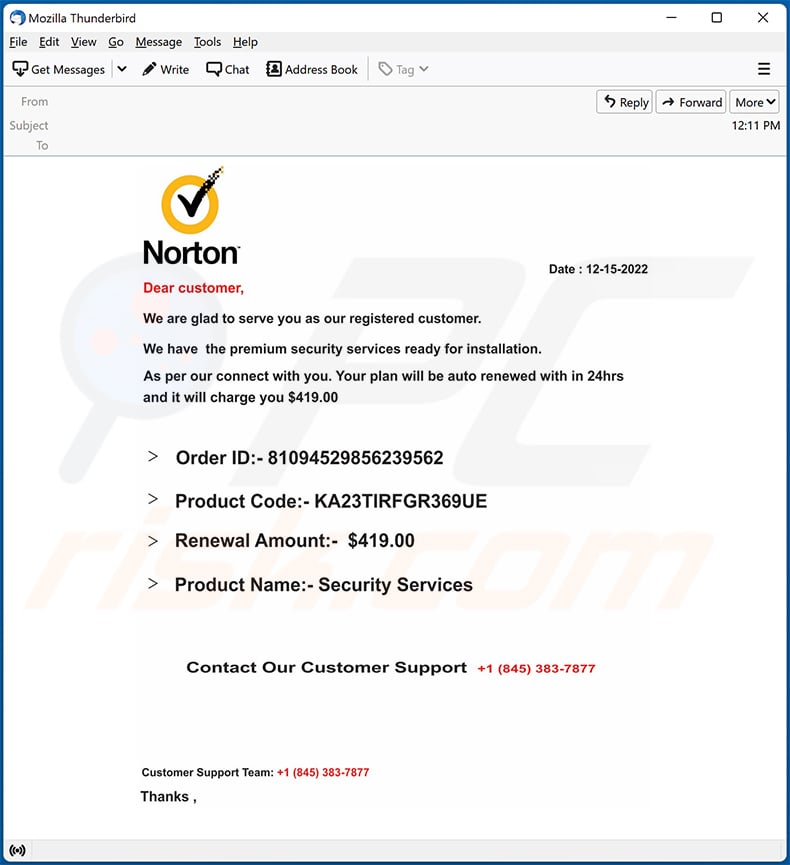
Text presented within:
Norton
Date : 12-15-2022
Dear customer,
We are glad to serve you as our registered customer.
We have the premium security services ready for installation.
As per our connect with you. Your plan will be auto renewed with in 24hrs and it will charge you $419.00> Order ID:- 81094529856239562
> Product Code:- KA23TIRFGR369UE
> Renewal Amount:- $419.00
> Product Name:- Security ServicesContact Our Customer Support +1 (845) 383-7877
Customer Support Team: +1 (845) 383-7877
Thanks,
Yet another example of Norton subscription renewal-themed spam email:
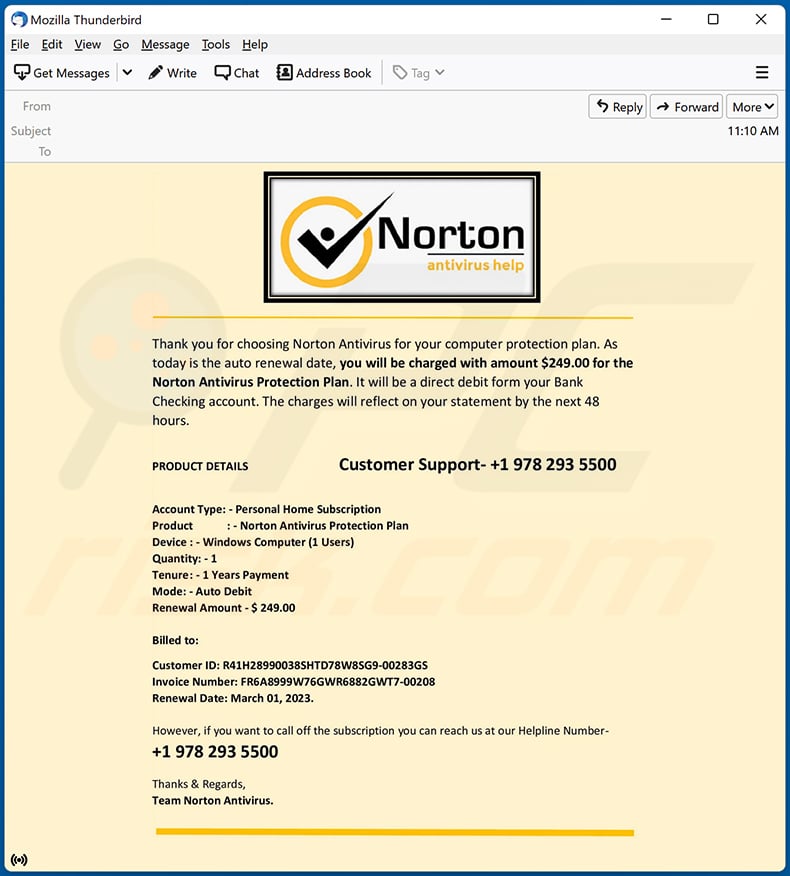
Text presented within:
Norton antivirus help
Thank you for choosing Norton Antivirus for your computer protection plan. As today is the auto renewal, you will be charged with amount $249.00 for the Norton Antivirus Protection Plan. It will be a direct debit form your Bank Checking account. The charges will reflect on your statement by the next 48 hours.
PRODUCT DETAILS
Customer Support- +1 978 293 5500Account Type: - Personal Home Subscription
Product : - Norton Antivirus Protection Plan
Device : - Windows Computer (1 Users)
Quantity: - 1
Tenure: - 1 Years Payment
Mode: - Auto Debit
Renewal Amount - $ 249.00Billed to:
Customer ID: R41H2890038SHTD78W8SG9-00283GS
Invoice Number: FR6A8999W76GWR6882GWT7-00208
Renewal Date: March 01, 2023.However, if you want to call off the subscription you can reach us at our Helpline Number-
+1 978 293 5500
Thanks & Regards,
Team Norton Antivirus.
Another example of an email from "Norton Subscription Will Renew Today" spam campaign:
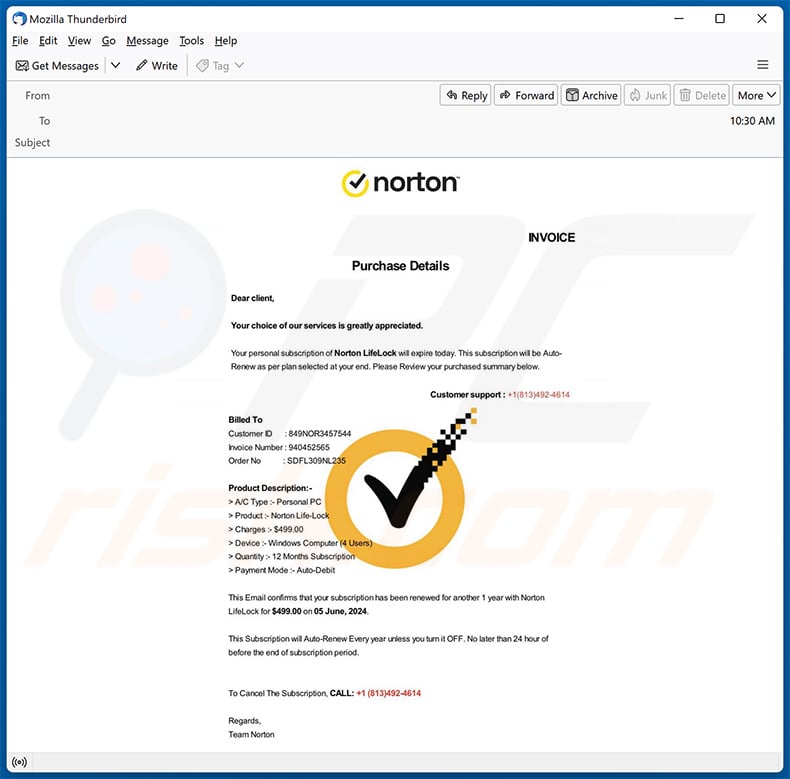
Text presented within:
norton
INVOICE
Purchase Details
Dear client,
Your choice of our services is greatly appreciated.
Your personal subscription of Norton LifeLock will expire today. This subscription will be Auto-Renew as per plan selected at your end. Please Review your purchased summary below.
Customer support: +1(813)492-4614
Billed To
Customer ID : 849NOR3457544
Invoice Number : 940452565
Order No : SDFL309NL235Product Description:-
> A/C Type :- Personal PC
> Product :- Norton Life-Lock
> Charges :- $499.00
> Device :- Windows Computer (4 Users)
> Quantity :- 12 Months Subscription
> Payment Mode :- Auto-DebitThis Email confirms that your subscription has been renewed for another for another 1 year with Norton LifeLock for $499.00 on 05 June, 2024.
This Subscription will Auto-Renew Every year unless you turn it OFF. No later than 24 hour of before the end of subscription period.
To Cancel The Subscription, Call: +1 (813)492-4614
Regards,
Team Norton
Instant automatic malware removal:
Manual threat removal might be a lengthy and complicated process that requires advanced IT skills. Combo Cleaner is a professional automatic malware removal tool that is recommended to get rid of malware. Download it by clicking the button below:
DOWNLOAD Combo CleanerBy downloading any software listed on this website you agree to our Privacy Policy and Terms of Use. To use full-featured product, you have to purchase a license for Combo Cleaner. 7 days free trial available. Combo Cleaner is owned and operated by RCS LT, the parent company of PCRisk.com.
Quick menu:
- What is Norton Subscription Will Renew Today spam?
- Types of malicious emails.
- How to spot a malicious email?
- What to do if you fell for an email scam?
Types of malicious emails:
![]() Phishing Emails
Phishing Emails
Most commonly, cybercriminals use deceptive emails to trick Internet users into giving away their sensitive private information, for example, login information for various online services, email accounts, or online banking information.
Such attacks are called phishing. In a phishing attack, cybercriminals usually send an email message with some popular service logo (for example, Microsoft, DHL, Amazon, Netflix), create urgency (wrong shipping address, expired password, etc.), and place a link which they hope their potential victims will click on.
After clicking the link presented in such email message, victims are redirected to a fake website that looks identical or extremely similar to the original one. Victims are then asked to enter their password, credit card details, or some other information that gets stolen by cybercriminals.
![]() Emails with Malicious Attachments
Emails with Malicious Attachments
Another popular attack vector is email spam with malicious attachments that infect users' computers with malware. Malicious attachments usually carry trojans that are capable of stealing passwords, banking information, and other sensitive information.
In such attacks, cybercriminals' main goal is to trick their potential victims into opening an infected email attachment. To achieve this goal, email messages usually talk about recently received invoices, faxes, or voice messages.
If a potential victim falls for the lure and opens the attachment, their computers get infected, and cybercriminals can collect a lot of sensitive information.
While it's a more complicated method to steal personal information (spam filters and antivirus programs usually detect such attempts), if successful, cybercriminals can get a much wider array of data and can collect information for a long period of time.
![]() Sextortion Emails
Sextortion Emails
This is a type of phishing. In this case, users receive an email claiming that a cybercriminal could access the webcam of the potential victim and has a video recording of one's masturbation.
To get rid of the video, victims are asked to pay a ransom (usually using Bitcoin or another cryptocurrency). Nevertheless, all of these claims are false - users who receive such emails should ignore and delete them.
How to spot a malicious email?
While cyber criminals try to make their lure emails look trustworthy, here are some things that you should look for when trying to spot a phishing email:
- Check the sender's ("from") email address: Hover your mouse over the "from" address and check if it's legitimate. For example, if you received an email from Microsoft, be sure to check if the email address is @microsoft.com and not something suspicious like @m1crosoft.com, @microsfot.com, @account-security-noreply.com, etc.
- Check for generic greetings: If the greeting in the email is "Dear user", "Dear @youremail.com", "Dear valued customer", this should raise suspiciousness. Most commonly, companies call you by your name. Lack of this information could signal a phishing attempt.
- Check the links in the email: Hover your mouse over the link presented in the email, if the link that appears seems suspicious, don't click it. For example, if you received an email from Microsoft and the link in the email shows that it will go to firebasestorage.googleapis.com/v0... you shouldn't trust it. It's best not to click any links in the emails but to visit the company website that sent you the email in the first place.
- Don't blindly trust email attachments: Most commonly, legitimate companies will ask you to log in to their website and to view any documents there; if you received an email with an attachment, it's a good idea to scan it with an antivirus application. Infected email attachments are a common attack vector used by cybercriminals.
To minimise the risk of opening phishing and malicious emails we recommend using Combo Cleaner Antivirus for Windows.
Example of a spam email:

What to do if you fell for an email scam?
- If you clicked on a link in a phishing email and entered your password - be sure to change your password as soon as possible. Usually, cybercriminals collect stolen credentials and then sell them to other groups that use them for malicious purposes. If you change your password in a timely manner, there's a chance that criminals won't have enough time to do any damage.
- If you entered your credit card information - contact your bank as soon as possible and explain the situation. There's a good chance that you will need to cancel your compromised credit card and get a new one.
- If you see any signs of identity theft - you should immediately contact the Federal Trade Commission. This institution will collect information about your situation and create a personal recovery plan.
- If you opened a malicious attachment - your computer is probably infected, you should scan it with a reputable antivirus application. For this purpose, we recommend using Combo Cleaner Antivirus for Windows.
- Help other Internet users - report phishing emails to Anti-Phishing Working Group, FBI’s Internet Crime Complaint Center, National Fraud Information Center and U.S. Department of Justice.
Frequently Asked Questions (FAQ)
Why did I receive this email?
Spam emails are not personal. The same email letter is received by thousands of users.
I have provided my personal information when tricked by this spam email, what should I do?
If you have provided account credentials - change the passwords of all potentially compromised accounts and contact their official support without delay. And if the disclosed information was of a different personal nature (e.g., ID card details, credit card numbers, etc.) - immediately contact the corresponding authorities.
I have allowed cyber criminals to remotely access my computer, what should I do?
If you have allowed cyber criminals to remotely access your device - first, you have to disconnect it from the Internet. Secondly, uninstall the remote access software you've been asked to install (e.g., AnyDesk, Team Viewer, etc.). And lastly, perform a full system scan and remove all detected threats.
I have read a spam email but didn't open the attachment, is my computer infected?
No, reading a spam email will not initiate any malware download/installation processes. Systems are infected when the files distributed through spam emails (e.g., attachments, download links) - are opened.
I have downloaded and opened a file attached to a spam email, is my computer infected?
Whether your system was infected - depends on the file's format. If it was an executable, most likely - yes. However, you might have avoided jumpstarting an infection if it was a document (e.g., .doc, .pdf, etc.). These formats can require additional actions (e.g., macro commands enablement) to initiate malware download/installation.
Will Combo Cleaner remove malware infections present in email attachments?
Yes, Combo Cleaner can detect and eliminate nearly all of the known malware infections. It is noteworthy that high-end malicious software is usually hidden deep within systems. Therefore, it is crucial to perform a full system scan.
Share:

Tomas Meskauskas
Expert security researcher, professional malware analyst
I am passionate about computer security and technology. I have an experience of over 10 years working in various companies related to computer technical issue solving and Internet security. I have been working as an author and editor for pcrisk.com since 2010. Follow me on Twitter and LinkedIn to stay informed about the latest online security threats.
PCrisk security portal is brought by a company RCS LT.
Joined forces of security researchers help educate computer users about the latest online security threats. More information about the company RCS LT.
Our malware removal guides are free. However, if you want to support us you can send us a donation.
DonatePCrisk security portal is brought by a company RCS LT.
Joined forces of security researchers help educate computer users about the latest online security threats. More information about the company RCS LT.
Our malware removal guides are free. However, if you want to support us you can send us a donation.
Donate
▼ Show Discussion